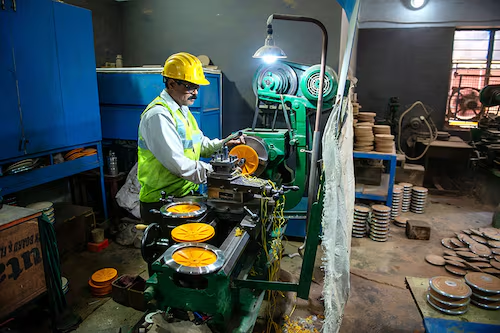India’s startup ecosystem, with over 1.74 lakh DPIIT-recognized startups as of April 2025, thrives on innovation, yet the venture capital (VC) model doesn’t suit all businesses. T.N. Hari, co-founder of Artha School of Entrepreneurship, argues that Middle India’s limited awareness of the VC ecosystem may be a blessing, encouraging frugal, profitable, and sustainable businesses. With 6.33 crore MSMEs (99.4% micro-enterprises) dominating India’s economy, as per the MSME Ministry’s FY19 report, the absence of a VC-driven mindset in Middle India fosters innovation aligned with local needs. This article explores why the VC model’s mismatch with Middle India’s low-margin, low-volume markets and the myths it perpetuates can be bypassed for sustainable growth, leveraging Startup India’s support.
The Structure of India’s Business Landscape
India’s MSME sector mirrors global trends, with 99.4% of its 6.33 crore enterprises classified as micro (revenue <₹5 crore, per MSME Development Act). Unlike a normal distribution, where most businesses would fall in the “middle” (small to medium enterprises), India’s business landscape shows a skewed pattern:
- Micro-Enterprises: 6.3 crore businesses, often without websites, employ <20 people and generate <₹1 crore in revenue.
- Large Enterprises: A tiny fraction (0.1%) like Reliance or Tata dominate, contributing 30% to GDP.
- Missing Middle: Small and medium enterprises (5–250 employees) are scarce, creating a “trough” in the distribution curve.
This skewed distribution, akin to Nassim Taleb’s “Black Swan” patterns in book sales or city populations, highlights why VC-driven scaling doesn’t suit most Indian businesses.
The VC Model: A Moonshot Misfit for Middle India
The VC model targets “moonshot” businesses with:
- Large Addressable Market: A multi-billion-dollar opportunity (e.g., fintech serving 500 million users).
- Superior Solution: 10x better than existing alternatives (e.g., UPI vs. traditional banking).
- Technology Tailwind: Leveraging AI, blockchain, or IoT for disruption.
Only 5–10% of VC-funded startups deliver outsized returns (e.g., 50x), with 70–80% failing within 5–7 years, per CB Insights. In 2024, Indian VCs invested $12.2 billion across 1,200 deals, but only 15% of funded startups achieved Series A, per Tracxn.
Middle India’s Market Reality
Middle India’s markets—Tier II/III cities and rural areas—are fragmented, low-margin, and low-volume:
- Fragmentation: Cultural, linguistic, and geographic diversity (e.g., 22 official languages, 1,600 dialects) increases customer acquisition costs (CAC) by 20–30%.
- Low Margins: Price sensitivity limits margins to 5–10% (e.g., FMCG retail in small towns).
- Low Volume: Scattered demand caps scale (e.g., 60% of MSMEs serve local markets).
The VC model’s 5–7-year exit timeline clashes with these constraints, as scaling fragmented markets requires 10–15 years of operational rigor, not rapid cash burn.
Why Middle India’s VC Ignorance Is a Blessing
Middle India’s limited exposure to VC culture avoids three pervasive myths, fostering sustainable businesses:
- Myth: Every Business Needs VC Funding
- Reality: Only 1–2% of Indian startups (2,800 of 1.74 lakh) are VC-funded, yet 60% of DPIIT-recognized startups are profitable without external capital. Example: AgroStar scaled to 5 million farmers using debt and revenue.
- Benefit: Middle India startups focus on unit economics, achieving cash positivity within 2–3 years (e.g., BigHaat’s 15% EBITDA margin).
- Myth: Growth Trumps Everything
- Reality: Cash burn for growth often masks poor product-market fit. In 2022, 40% of Indian unicorns (e.g., BYJU’s) faced valuation cuts due to unsustainable growth.
- Benefit: Middle India startups prioritize profitability, with 70% of MSMEs reporting positive cash flow in FY23, per MSME Ministry.
- Myth: Cash Burn Drives Discoverability
- Reality: High CAC (e.g., ₹500–₹1,000 per user in e-commerce) signals weak demand. Example: Info Edge’s Naukri.com achieved PMF with minimal marketing by solving a real job-seeker problem.
- Benefit: Frugal innovation, like CropIn’s AI platform for 7 lakh farmers, leverages local insights for low-cost customer acquisition.
Example: A Kanpur-based AgriTech startup, unaware of VC norms, used ₹10 lakh in debt to build a soil-testing drone, achieving ₹50 lakh in revenue within 18 months, serving 5,000 farmers profitably.
Mass Flourishing: Middle India’s Innovation Edge
Edmund Phelps’ Mass Flourishing highlights that prosperity stems from widespread innovation, not just a few visionaries. Middle India’s 6.3 crore micro-enterprises embody this, solving local problems (e.g., affordable irrigation tools) without VC pressure. Startup India’s support amplifies this:
- Seed Fund Scheme: ₹600 crore disbursed to 2,000+ startups in 2024, ideal for non-VC businesses.
- GeM Platform: ₹1,200 crore in orders for startups, enabling market access for rural enterprises.
- IP Support: 80% patent fee rebates, with 5,000 startups filing patents in 2024.
Example: Salam Kisan, a DPIIT-recognized startup, trained 58,000 farmers (15% women) in drone-based farming, scaling without VC funding via GeM contracts.
Challenges and Opportunities
- Challenges:
- Digital Literacy: 40% of Middle India’s MSMEs lack digital skills, limiting tech adoption.
- Access to Debt: Only 15% of MSMEs secure formal credit, per RBI.
- Market Fragmentation: High CAC and logistics costs (10–15% of revenue) hinder scaling.
- Opportunities:
- Leverage Startup India’s learning modules for digital training, reaching 1 lakh startups in 2024.
- Use CGSS for collateral-free loans (₹10 crore limit) within 90 days of DPIIT recognition.
- Focus on hyper-local solutions (e.g., regional-language apps) to reduce CAC by 20%.
Conclusion
Middle India’s lack of VC ecosystem knowledge is a blessing, steering entrepreneurs toward frugal, profitable, and sustainable businesses that align with local, low-margin, low-volume markets. By avoiding VC myths—universal funding needs, growth obsession, and cash burn—startups like AgroStar and CropIn thrive on customer-centric models. Entrepreneurs should register for DPIIT recognition within 60 days, leverage Startup India’s Seed Fund and GeM for non-dilutive growth, and focus on unit economics within 12 months. Middle India’s micro-enterprises, embodying Mass Flourishing, drive innovation for India’s $5 trillion economy goal, proving that profitability trumps VC hype.
Disclaimer: This article is for educational purposes and does not constitute financial or legal advice. Consult certified advisors and verify details with DPIIT or MSME authorities.

